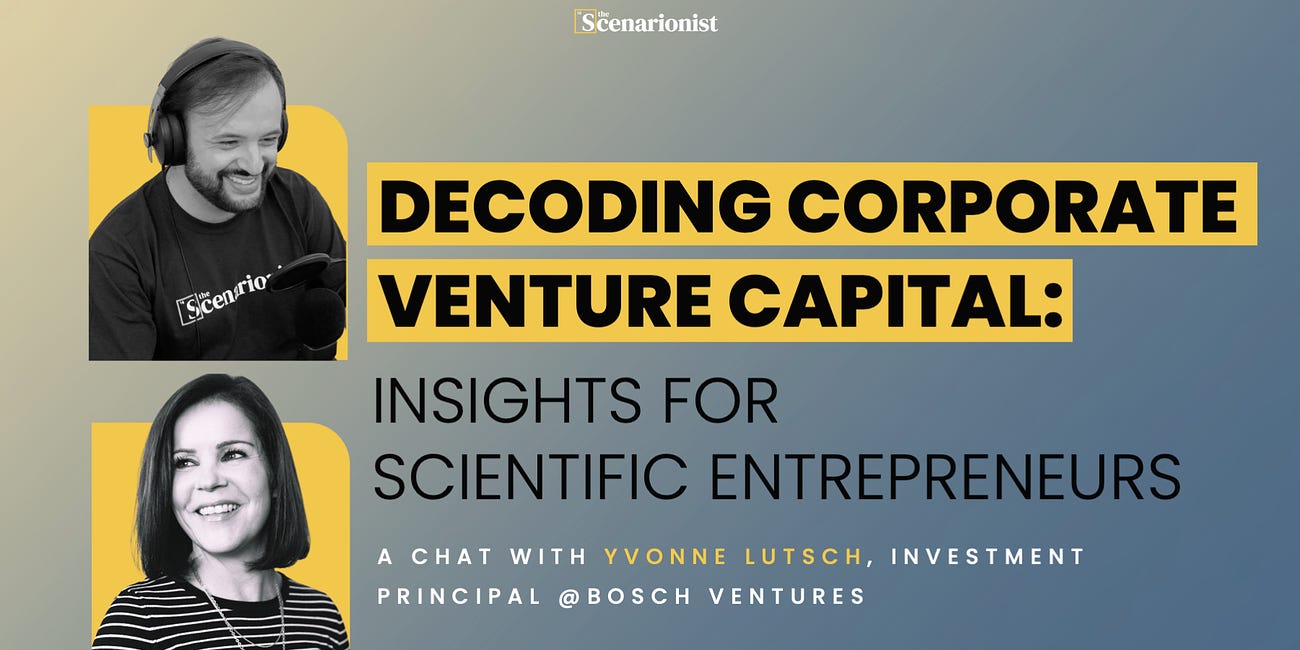Welcome to the 2nd episode of Deep Tech Catalyst!
In this episode, we are delighted to welcome Guerric De Crombrugghe, Founding Partner at Nuketech, as we delve deep into the intricacies of Market Traction and Company Shares.
From mastering the art of gathering invaluable market feedback to unlocking the true potential of a Letter of Intent and your company shares, this episode explores pivotal facets for scientists venturing into the world of deep tech startups.
Enjoy!
🎧 Prefer to listen?
⚛️ Nuclear Energy Industry: An Opportunity for Founders and Investors?
In the nuclear energy market and industry, there are several significant opportunities today for founders and investors, as highlighted in the interview:
Modernization of the Nuclear Industry: There's substantial room for innovation in the nuclear industry, which has remained relatively unchanged for decades. This includes developing new technologies, optimizing existing processes, and implementing advanced digital and robotic solutions.
Enabling Technologies: Startups that develop technologies supporting both current and future nuclear industry, such as robotics, new materials, advanced manufacturing techniques, and digital solutions, hold significant potential. Adopting private 5G networks and integrating IoT sensors to improve data collection and operational efficiency are concrete examples.
Ambitious and Innovative Projects: Opportunities exist for bolder projects, such as developing next-generation nuclear reactors and solutions for the nuclear fuel cycle. These projects could offer long-term solutions for low-carbon energy production and efficient fuel use.
Room for New Entrants: Being an industry not yet crowded with new participants, founders, and investors have the chance to capitalize on being early movers, gaining a solid market position.
Sustainability and Climate Change: With increasing emphasis on reducing greenhouse gas emissions and sustainable energy production, the nuclear industry offers a significant pathway to contribute to decarbonization, making it attractive for investors interested in positive social and environmental impacts.
Partnerships and Collaborations: Collaborating with universities and research centers can provide opportunities to turn scientific discoveries into commercial applications and foster the development of new technologies and innovative solutions in the nuclear sector.
🧑🔬 Insights for Aspiring Deep Tech Founders
⚙️ Understanding TRL4/5 and VC Expectations
When navigating the landscape of technology readiness at levels 4 and 5, it's crucial to grasp what venture capitalists seek in these early stages of tech development.
At TRL4 and TRL5, technology integration and validation are in focus:
Proof of Concept Beyond Lab: VCs look for technologies that have progressed beyond the lab, tested in conditions simulating the real world.
Initial Market Validation: Evidence of market interest is key, often through preliminary agreements or discussions with potential customers.
Clear Path to Further Development: A strategic roadmap for advancing the technology is essential, detailing resource needs, timelines, and potential obstacles.
Research Project vs. Investable Company
Differentiating a research project from an investable company is vital in the transition from science to business, especially in deep tech and nuclear sectors:
Research Project: Often exploratory and focused on scientific or technological innovation without a direct commercial application.
Investable Company: Characterized by a business model that addresses market needs, potential for profitability, scalability, and a defined customer base.
Risk-Aversion in Companies
Understanding risk-aversion is crucial for founders:
Risk-Aversion: It reflects a preference for safer outcomes and can lead to hesitancy in adopting new technologies.
Overcoming Risk-Aversion: Demonstrating exceptional performance, reliability, and compliance with standards is critical to gain acceptance.
Driving Motivations for Founders
A founder’s motivation can significantly impact the trajectory of a deep tech venture. These motivations are often rooted in a mix of passion and practicality:
Passion for Innovation: A driving force should be the desire to push the boundaries of technology and science.
Desire to Solve Real-World Problems: Aiming to make a tangible impact in fields like energy, environment, or technology is crucial.
Importance of High-Performing Technology and Products
The performance level of a technology or product can make or break its market acceptance, particularly in sectors where safety and efficiency are paramount:
Adoption Barriers: High performance and reliability can decisively break down barriers to market entry.
Building Trust: Superior products help in building trust among early adopters, especially in sensitive industries like nuclear energy.
🏭 Market Traction 101 for Deep Tech Ventures
Market traction is a critical factor for the success of any deep tech venture. It's not just about building a technology, but about creating something that addresses a real market need.
Understanding Market Needs: To ensure market relevance, step out of the laboratory and engage with potential customers. This interaction provides insights into the market's needs and whether your technology addresses these needs.
Feedback and Adaptation: Use feedback from these interactions to adapt and refine your technology, ensuring it aligns with market demands.
Market traction is evidence that your product or service has begun to gain acceptance and interest in the market. Demonstrating market traction is crucial for attracting investors, as it shows potential for growth and revenue generation. In Deep Tech, market traction can be validated through pilot projects, partnerships, or pre-orders. It’s about showing real, tangible interest in your technology.
Testing Market Traction
Different strategies can be used to test and validate market traction in deep tech:
Pilot Projects and Partnerships: Collaborating with industry players for pilot projects can provide valuable validation.
Customer Feedback and Pre-orders: Gathering feedback and securing pre-orders are tangible indicators of market interest.
📝 Understanding Letters of Intent (LOI)
A letter of intent is a document outlining an agreement between two parties before a deal is finalized.
Function of an LOI: It typically indicates a serious intention to do business but is not legally binding like a contract.
Contents of an LOI: It outlines the interest of a potential customer or partner in your technology, often stating intentions for future purchases or collaboration.
Significance of an LOI: While not a contract, an LOI is valuable as it demonstrates early interest and potential market adoption, which is crucial for investor confidence.
Obtaining a Letter of Intent
Securing an LOI involves several steps:
Identifying Potential Signatories: Start by identifying industry experts or potential customers who would benefit from your technology.
Engagement and Presentation: Engage with these entities, present your technology, and articulate its value proposition.
Drafting the LOI: Once interest is confirmed, draft an LOI that summarizes the discussions and indicates a mutual intention to proceed in some capacity.
Importance of LOIs for Deep Tech Founders
For entrepreneurs, especially in the deep tech sector, LOIs serve as a powerful tool:
Validation of Concept: An LOI provides external validation of the technology's potential.
Building Credibility: It helps in building credibility with investors and other stakeholders.
Guidance for Future Development: The interest expressed in the LOI can guide further technology development and business strategy.
🎖 Track Record and Documentation
For tech startups seeking investment, understanding the importance of thorough documentation, differentiating between key enabling and revolutionary technologies, and recognizing the significance of being post-revenue or post-profit is crucial. These elements not only aid in attracting the right investors but also in establishing a clear narrative of the startup’s journey, potential, and financial health. Properly presented, this information can significantly enhance the appeal of the startup to potential investors.
Why does a strong track record matter?
For investors, documentation is essential to understand and evaluate a startup's potential. It serves as a tangible record of the startup's vision, market viability, and operational competence.
Risk Assessment and Due Diligence: Proper documentation allows investors to conduct thorough due diligence, assessing the risks and potential returns of their investments.
Validation of Assumptions: It provides evidence to back up the claims made by the founders about their technology, market traction, and business model.
💸 Post-Revenue vs. Post-Profit in Deep Tech Startups
Understanding the financial stage of a startup is crucial for investors, as it provides insight into the company's growth stage and financial health.
Post-Revenue: This indicates that the startup has begun generating revenue, though it may not yet be profitable. This stage shows market validation and the ability of the product or service to attract paying customers.
Post-Profit: Implies that the startup is not only generating revenue but also earning profits. This is a further step in financial maturity, indicating a more stable financial position and potentially lower investment risk.
Importance for Investors
For investors, these distinctions and stages provide critical insights into the investment's potential risks and rewards.
Assessing Growth and Risk: Understanding whether a startup is post-revenue or post-profit helps in assessing its growth trajectory and financial stability.
Alignment with Investment Strategy: Investors often have preferences based on the maturity and sector of a startup. Knowing the difference between key enabling technologies and revolutionary startups helps them align their investments with their strategic goals.
🍰 Cap Table and Shares 101 for Deep Tech Startups
Understanding the capitalization table (cap table) and shares is crucial for deep tech startups, especially those spinning out from academic institutions. This knowledge is key to attracting investment and ensuring long-term viability.
Importance of Cap Table for Investability
The cap table is a cornerstone for startups, showing the share ownership and equity value.
Early-Stage Equity Offering: For early-stage startups, especially from academia, equity (shares) is often the only asset they can offer to investors in exchange for funding.
Weak Points for Academic Spinouts: Academic spinouts often struggle with cap table management due to a lack of business experience and the complexities of transitioning from an academic project to a commercial enterprise.
Understanding Equity and Shares
Grasping the concepts of equity and shares from the beginning is vital for the success of a startup.
Initial Equity Distribution: Founders must understand the implications of equity distribution, as it determines control, value, and future fundraising capabilities.
Cost-Effectiveness of the Entrepreneurial Idea: Properly managed equity ensures that the startup remains attractive to future investors and maintains enough incentives for founders and key employees.
Challenges in Changing the Cap Table
Altering the cap table post-creation can be complex and costly.
Complexity and Legal Implications: Once shares are distributed, changing the ownership structure involves legal processes and can have tax implications.
Investor Perspectives on Non-Ideal Cap Tables: Investors often view a poorly structured cap table as a red flag, indicating potential future conflicts and dilution issues.
Common Situations for Deep Tech Startups
Deep tech startups, particularly academic spinouts, often face unique challenges regarding their cap table.
University Relationships: The relationship with the parent university is crucial. Universities often take equity stakes in spinouts, which need to be balanced to keep the cap table attractive to external investors.
Typical Standards and Best Practices: A common benchmark in equity distribution is ensuring that founders retain significant control in early rounds, with the university and initial investors taking a reasonable but not excessive share.
🧠 Communication in Deep Tech
Fear of idea theft is a common concern among scientists and entrepreneurs, but it's often unfounded and can hinder necessary market engagement. Engaging early with potential customers is crucial for validation and product refinement.
Will they steal my idea?
Many scientists and entrepreneurs worry about idea theft, but this concern is often overblown and can be a barrier to valuable communication.
The true challenge lies in executing an idea rather than just conceiving it. This reality often mitigates the risk of idea theft. Scientists tend to overestimate the risk of idea theft due to their academic background, where novelty is highly valued.
Importance of Early Communication with Potential Customers
Early interaction with potential customers is crucial for market validation and refining the business approach.
Market Validation: Direct communication with potential customers validates the need for the product in the market, ensuring development is aligned with actual demand.
Feedback Loop: Such interactions provide feedback essential for refining the product and tailoring it to market needs.
This is all for today! 👋
Wanna be more involved?
👉🏻 Follow our LinkedIn page and drop a DM!
👉🏻 Write us a line here: info@thescenarionist.org
























